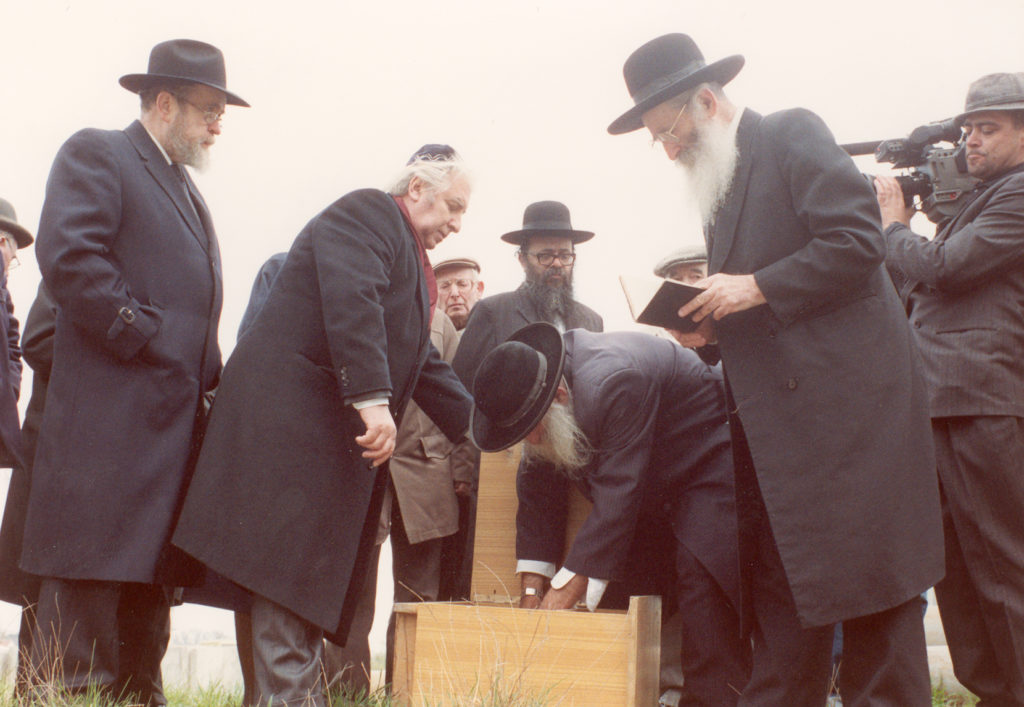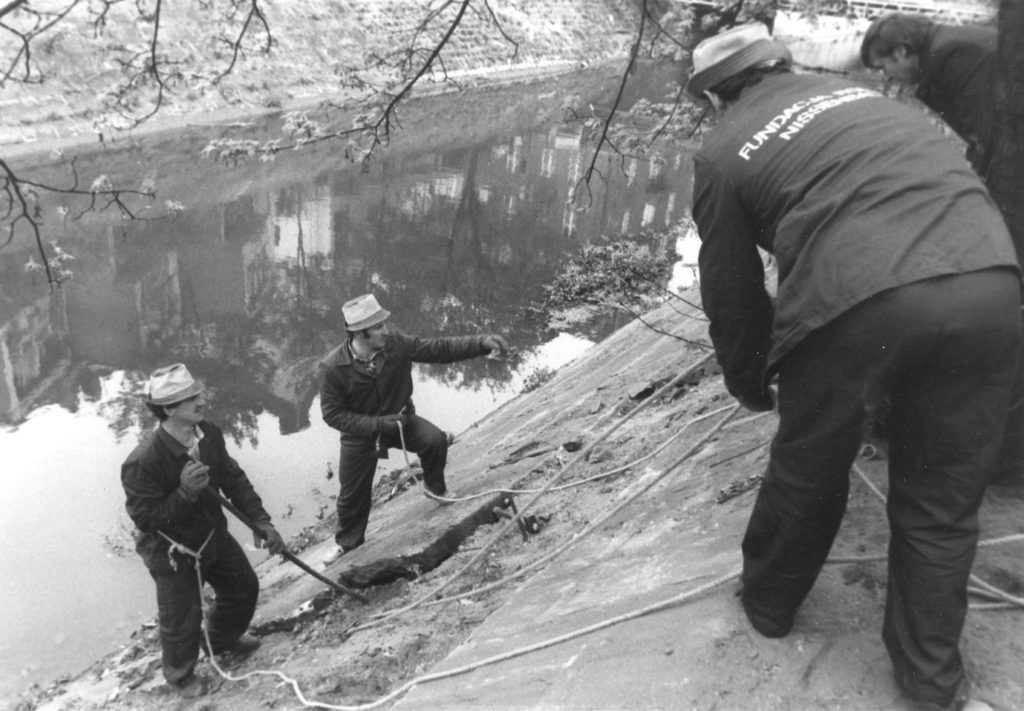The Nissenbaum Family Foundation
The Nissenbaum Family Foundation, established in 1983 with the aim of saving Jewish heritage in Poland, was the first foundation to be established in Poland since World War II (www.nissenbaum.pl).
These tombstones were used by the Germans to reinforce a nearby river embankment, where they remained until 1989. In an effort to draw attention to the desecration of Jewish cemetery in Kalisz (founded in the 13th century), the Nissenbaum Family Foundation, which preserves Jewish cemeteries in Poland, took 2000 stones from the river and put them at the edge of the school sports ground which was built in the 1960s. They were then taken away to the new Jewish cemetery and placed in the memorial wall.
The Nissenbaum Family Foundation became interested in the Old Jewish Cemetery in Kalisz in June 1988. Dating from 1287, the cemetery is located in the area of Skalmierzycka, Handlowa and Nowy Świat Streets.
In October 1988, the secretary of the Kalisz Association in Israel informed the Foundation that the Rypinkowski Canal, running through Kalisz and built for the city in 1842-1843, is lined with matzevot from the so-called The Old Jewish Cemetery.
Due to the coming winter, the works started in the spring of the following year. In May 1989, employees of the Nissenbaum Family Foundation removed about 2,000 matzevas from the canal. They were temporarily lodged in the New Cemetery, which was established in 1896. The oldest of them were from the 15th and 16th centuries.
At the same time, works related to the construction of the municipal heating pipeline were carried out in the Old Cemetery. During the works, the workers found human remains. Therefore, the Nissenbaum Family Foundation intervened in this matter, demanding that the construction works be stopped. At the same time, she intervened in the matter of stealing matzevot from the New Cemetery. After examining them, it turned out that they came from the Old Cemetery and that is why they were moved there in early 1990. Throughout this period, the Nissenbaum Family Foundation carried out its own work in the New Cemetery.
Repeated efforts by the Foundation eventually led to the fact that in 1991 the city authorities revoked the decision to locate the heating pipeline at the Old Jewish Cemetery. In March 1991, the State Treasury allocated 800 million old zlotys to modify the plan to route the heat pipe through a different route. It was agreed that the cemetery area would be commemorated and the Foundation would build an ohel over the tomb of Tzadik Gombiner. On April 16, 1991, the ritual burial of the excavated tzadik’s remains together with the ground took place.
On July 5, 1991, another dispute broke out: on the order of the local voivode, the matzevot from the Old Cemetery were moved to the New Cemetery. The idea was to create a playground at the oldest Jewish cemetery in Poland. The Nissenbaum Family Foundation protested against these actions, addressing the Council for Polish-Jewish Relations and the President of the Republic of Poland.
* Abraham Abel Gombiner, Avraham Abele Halevi from Gąbin, Magen Avraham, Abraham Kalisch (born in 1634 in Gąbin – died in 1682 in Kalisz) – philosopher, tzadik, assistant to the rabbi of Kalisz, dayan, author of commentaries to “Szulchan Aruch “.
Abraham Abel Gombiner was the son of Rebbe Chaim Gombiner of the Levite family. After the death of his parents, he left Gąbin and went to Vilnius, where he studied with Jakub Izaak Gombiner. After the slaughter of Vilnius in 1655 by Bohdan Chmielnicki’s Cossacks, he came to Kalisz and settled there permanently.
Gombiner was one of the greatest Talmudists of his time, as is evident in his commentary titled “Magen Avraham,” written to the “Orach Chajim” chapter of “Shulchan Aruch.” Tzadik Gombiner wrote it at the age of thirty. 1692 “Magen Avraham” had a great influence on the religious practices of the followers of Judaism. According to his study, among Ashkenazi Jews, the hours of prayer are established. He also wrote a book called “Zajit Raanan” (Green Olive Tree), published in Dessau in 1704. It contains reflections on Kabbalah, to which Gombiner added part of his Torah commentary, “Shemen Sason” (Oil of Joy / Pleasure), and commentary on “Shulchan Aruch” – “Ewen ha ezer”, along with a special essay on the proper pronunciation of Jewish names in official documents, as well as notes on the treatises “Zewahim” and “Menachot”.
Gombiner also wrote religious poetry.

Archive of the Nissenbaum Family Foundation
“Reburial at the cemetery in Kalisz“; standing from the left:
a) Rabbi Hertz Frankel,
b) Sigmund Nissenbaum,
c) in the middle (with a black hat): Rabbi Schmiedel;
d) bowing over the coffin: Rabbi Shimon Anshin;
e) standing to the right (with a grey beard): the Chief Rabbi of Poland, Pinkas Joskowicz

Reburial of the bones at the cemetery in Kalisz

Reburial; standing from the left:
Rabbi Schmiedel,
Rabbi Anshin,
unknown person;
bowing over the coffin: Sigmund Nissenbaum

The river channel in Kalisz
on the both sides of it you can see matzevot

The river channel in Kalisz:
Employees of the Nissenbaum Family Foundation at work

The river channel in Kalisz
Employees of the Nissenbaum Family Foundation at work

The river channel in Kalisz
Employees of the Nissenbaum Family Foundation at work

The matzevot taken out of from the river channel

The President of the Nissenbaum Foundation
Sigmund Nissenbaum and his wife, Sonja Nissenbaum,
watching the employees of the Nissenbaum Family Foundation at work
